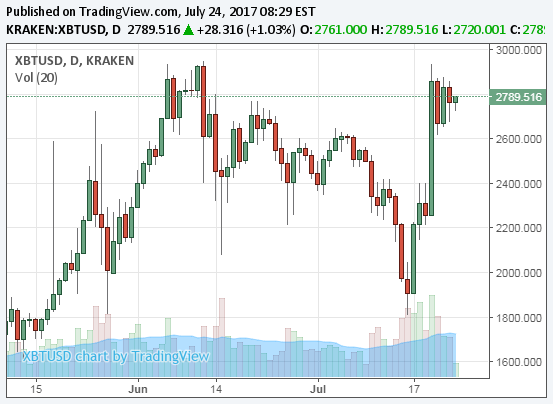
Do Bitcoin, Ethereum and Cryptocurrency CFDs need to be reported for EMIR Regulation?
Quick, do a Google search for Ethereum. There is a good chance that you will see an ad from a broker like this one.

After being on fire in 2013 and then falling in 2014, bitcoins and the wider cryptocurrency industry are back. Helping lead the way has been ethereum, a distributed ledger technology created from the ground for users to launch their own crypto based assets.
Most recently, ethereum has been used to power many multi-million dollar Initial Coin Offerings (ICOs). In a ICO, a company, or group can create a new crypto coin that operates on Ethereum and acts like shares of the venture. Like an IPO where a company sells its stock to the public and the is listed on an exchange, a percentage of the new crypto coin is exchanged for other cryptocurrenies in an ICO.
The result is that beyond bitcoin, litecoin, ethereum, there are also many popular ICO based cryptocurrencies attracting trader’s attention.
Cryptocurrency CFDs
Taking advantage of the popularity, many brokers and technology providers have created CFDs based on cryptocurrencies. These CFDs are derivatives that trade based on the price of the underlying cryptocurrency.
Similar to other CFDs and forex products, cryptocurrency CFDs can be traded with leverage and short positions. This contrasts to traditional crypto exchanges that don’t provide margin trading or short sales.
Cryptocurrencies CFDs and EMIR Reporting
As these CFDs are derivatives, a question exists if they fall under scope for EMIR Reporting regulation?
Put into effect in 2014, EMIR required that EEA firms report daily their derivative trades, counterparties and mark to market exposure. (More on EMIR Reporting)
To answer, we need to understand what type of derivatives are under scope of EMIR Reporting and whether bitcoins and other cryptos fall in those categories.
First, let’s try to define just what are cryptocurrencies, are they are a commodity, currency or new asset class?
As of publishing of this article, the European Securities and Markets Authority (ESMA) has yet to classify bitcoins and the cryptocurrencies. However, they have referred to them in several public releases. The most notable case is a Discussion Paper about Distributed Ledger Technologies (DLT).
In that paper, and other public statements, bitcoins and similar DLT based products have been referred to as virtual currencies. This is important as it provides a point of reference that cryptocurrency CFDs are a derivative based on an underlying currency.
Also, the CSSF, Luxembourg’s financial regulator, views at least bitcoins as a currency as they granted Bitstamp a financial license under their Payment Institution regulation.
Currency derivatives and EMIR
Having defined cryptocurrencies as a currency, are their CFD derivatives under scope?
This is where things become a little tricky. When listing EMIR reportable asset classes, ESMA includes currencies in this list. However, in ESMA’s Article 9 Final Report, they limit the definition of reportable currencies to those with an ISO 4217 three digit code. Examples are USD, GBP and EUR (complete list).
Currently, cryptocurrencies, including bitcoin, don’t have an accepted ISO 4217 code. There has been a strong movement to gain approval of XBT and XRP as the ISO 4217 code for bitcoins and ripple respectively. However, despite XBT and XRP appearing in various financial transactions, the code continues to be unofficial.
Cappitech opinion
Based on these EMIR and ESMA definitions, it is Cappitech’s understanding that until:
- ESMA expands definition of currencies to include non-ISO 4217 listed currencies; or
- ESMA defines cryptocurrencies as commodities and not currencies; or
- Cryptos receive an ISO 4217 code,
Bitcoins and other cryptocurrenies are not under scope for EMIR Reporting
Can you report them anyway?
If they aren’t under scope, can and should a broker go ahead and report them anyway? At Cappitech, this is a question we have often received.
Reporting cryptocurrencies using a non-ISO 4217 code such as XTB or BTC for bitcoin, generates rejections from Trade Repositories that EMIR reports are submitted to. This is due to ESMA not accepting non-ISO 4217 currency codes as correct syntax for EMIR Reporting.
As such, firms that elect to report these trades despite receiving errors risk increasing their ‘rejected trade’ numbers. This can cause them to be flagged by ESMA and their local regulator as a potential violator of EMIR Reports.
Also, Cappitech’s feedback from multiple Trade Repositories is they have been informed by local regulators and ESMA to improve report quality and not to ‘over-report’ positions that create unnecessary errors.
To summarize, answering the question of whether cryptocurrency CFDs are reportable under EMIR Reporting, Cappitech doesn’t believe they are under scope and there are risks if a broker goes ahead and reports them.






